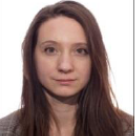
Oksana Shkurat
Work place: Department of Computer Systems Software, Igor Sikorsky Kyiv Polytechnic Institute, Kyiv, 03056, Ukraine
E-mail: shkurat@pzks.fpm.kpi.ua
Website:
Research Interests: Artificial Intelligence, Computer Vision, Image Processing
Biography
Oksana Shkurat, Assistant professor at the Department of Computer Systems Software of the Faculty of Applied Mathematics at the Igor Sikorsky Kyiv Polytechnic Institute. Research interests: Image Processing Technologies, Computer Vision Technologies, Artificial Intelligence.
Author Articles
Low-Light Image Enhancement Technology Based on Image Categorization, Processing and Retinex Deep Network
By Zhengbing Hu Oksana Shkurat Krzysztof Przystupa Orest Kochan Marharyta Ivakhnenko
DOI: https://doi.org/10.5815/ijigsp.2024.05.01, Pub. Date: 8 Oct. 2024
Low-light scenes are characterized by the loss of illumination, the noise, the color distortion and serious information degradation. The low-light image enhancement is a significant part of computer vision technology. The low-light image enhancement methods aim to an image recover to a normal-light image from dark one, a noise-free image from a noisy one, a clear image from distorting one. In this paper, the low-light image enhancement technology based on Retinex-based deep network combined with the image processing-based module is proposed. The proposed technology combines the use of traditional and deep learning methodologies, designed within a simple yet efficient architectural framework that focuses on essential feature extraction. The proposed preprocessing module of low-light image enhancement is centered on the unique knowledge and features of an image. The choice of a color model and a technique of an image transformation depends on an image dynamic range to ensure high results in terms of transfer a color, detail integrity and overall visual quality. The proposed Retinex-based deep network has been trained and tested on transformed images by means of preprocessing module that leads to an effective supervised approach to low-light image enhancement and provide superior performance. The proposed preprocessing module is implemented as an independent image enhancement module in a computer system of an image analysis and as the component module in a neural network system of an image analysis. Experimental results on the low light paired dataset show that the proposed method can reduce noise and artifacts in low-light images, and can improve contrast and brightness, demonstrating its advantages. The proposed approach injects new ideas into low light image enhancement, providing practical applications in challenging low-light scenarios.
[...] Read more.Grayscale Image Colorization Method Based on U-Net Network
By Zhengbing Hu Oksana Shkurat Maksym Kasner
DOI: https://doi.org/10.5815/ijigsp.2024.02.06, Pub. Date: 8 Apr. 2024
A colorization method based on a fully convolutional neural network for grayscale images is presented in this paper. The proposed colorization method includes color space conversion, grayscale image preprocessing and implementation of improved U-Net network. The training and operating of the U-Net network take place for images represented in the space of the Lab color model. The trained U-Net network integrates realistic colors (generate data of a and b components) into grayscale images based on L-component data of the Lab color model. Median cut method of quantization is applied to L-component data before the training and operating of the U-Net network. Logistic activation function is applied to normalized results of convolution layers of the U-Net network. The proposed colorization method has been tested on ImageNet database. The evaluation results of the proposed method according to various parameters are presented. Colorization accuracy by the proposed method reachers more than 84.81%. The colorization method proposed in this paper is characterized by optimized architecture of convolution neural network that is able to train on a limited image set with a satisfactory training duration. The proposed colorization method can be used to improve the image quality and restoring data in the development of computer vision systems. The further research can be focused on the study of a technique of defining optimal number of the gray levels and the implementation of the combined quantization methods. Also, further research can be focused on the use of HSV, HLS and other color models for the training and operating of the neural network.
[...] Read more.Other Articles
Subscribe to receive issue release notifications and newsletters from MECS Press journals